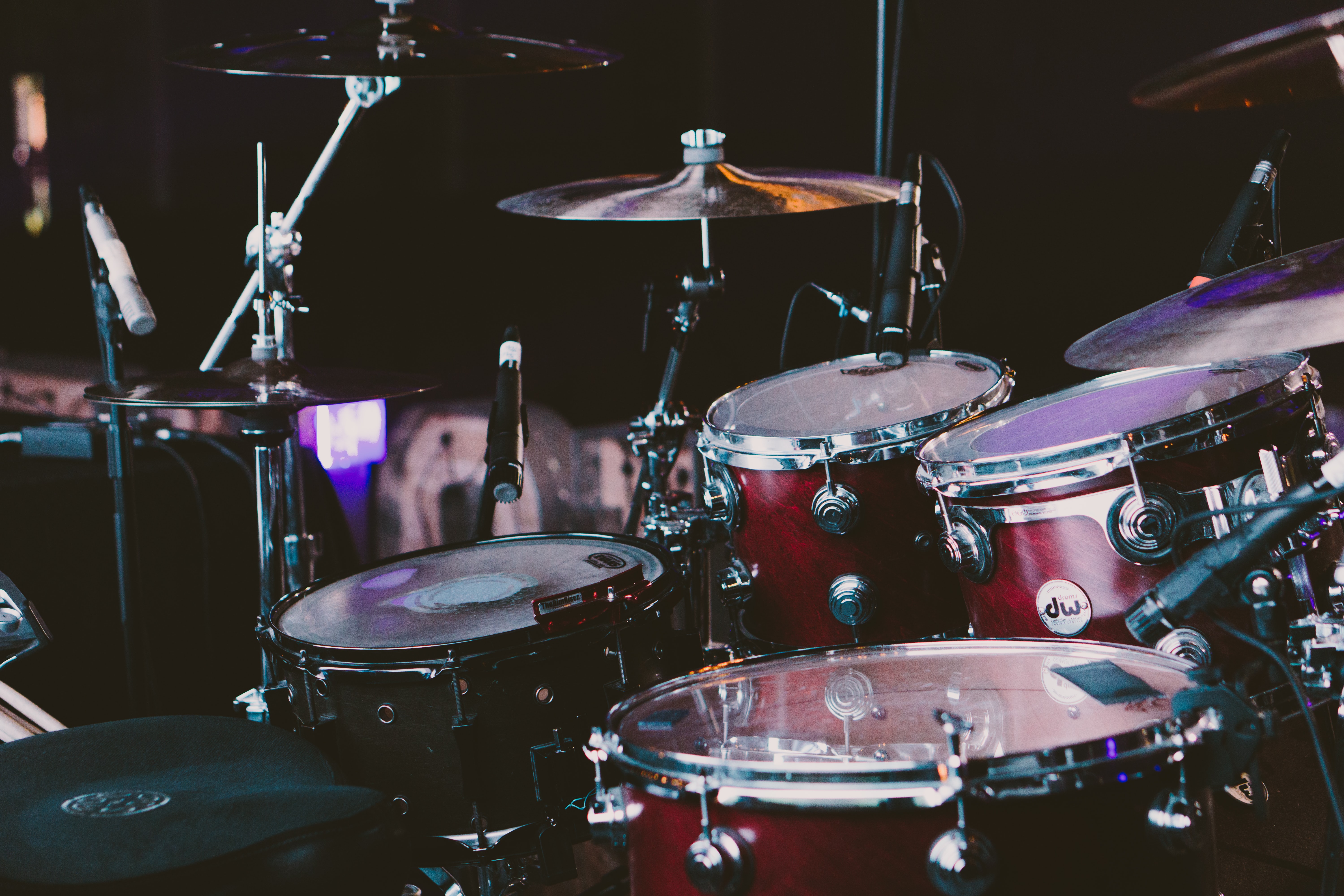
Here’s a drumming secret: every single movement made when drumming is controlled by different joints and gears in the body. To make these movements second nature, you’ll need to know everything about drum set parts and their arrangements. Understanding everything about your drum set will be a massive benefit to your familiarity with the right movements.
Understanding the various parts of a drum kit will also help you tell what sound a particular drum piece makes, and allow you to differentiate between different parts by ear. With this knowledge and some practice, you'll learn how to recreate basic beats you hear. Continue reading this article to learn everything about the parts of a drum kit.
Table of Contents
- How Many Pieces Does a Drum Set Have?
- Bass Drum
- Snare Drum
- Tom Toms
- Cymbals
- Drumsticks
- Drum Throne
- Metronome
- Getting Your First Drum Set
How Many Pieces Does a Drum Set Have?
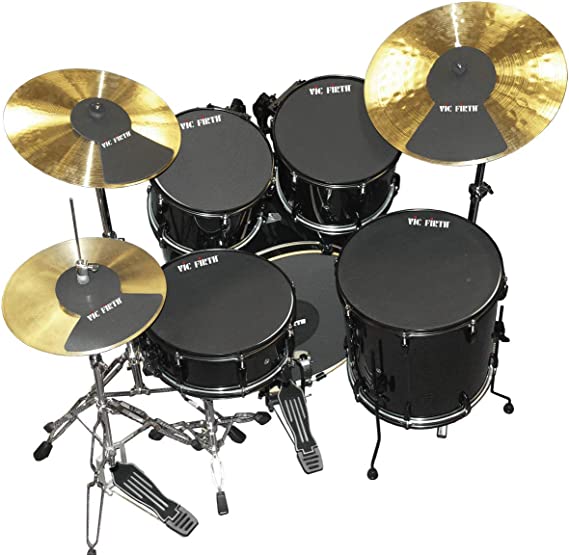
The many pieces of a drum kit. Photo Source: Amazon
The number of pieces in a drum kit will vary depending on the setup, but the most basic setup is the five-piece. When counting the pieces in a drum kit, the cymbals and other drum hardware aren’t included. This means that a five-piece drum kit has five drums and any number of other drum parts, such as cymbals, drum sticks, and the drum throne. The typical five-piece drum set includes:
- Bass drum
- Snare drum
- High tom
- Mid tom
- Floor tom
Bass Drum
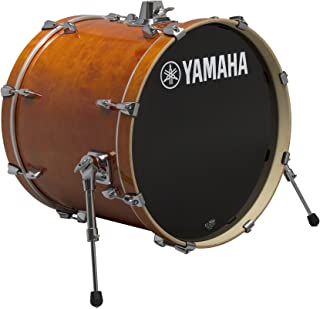
The Might Bass Drum Photo Source: Amazon
The bass drum, also called the kick drum, is the largest of all drum set parts and is played with a beater controlled by a pedal. As its name implies, the bass drum is responsible for the low kick sound, which is easily identifiable and useful to keep time.
Bass drums have a drum head on both sides of their shells. The resonant head doesn’t take direct hits, but can be manipulated to alter the sound of your bass drum. Some of the common ways this is done include:
- Removing the resonant head of the kick drum which will allow air to leave it faster and let sound travel further.
- Cutting out a hole in the resonant head to reduce the rebound from the kick drum’s beater
- Stuffing pillows or other soft and plush surfaces to alter the resonance and better define the kick drum’s sound
The size and frame material of your bass drum also affect its sound. Larger bass drums produce deeper tones than smaller ones, and wooden shells give warmer sounds than plastic ones. The pitch also varies based on the drum’s diameter.
Another interesting way to change the variety of your kick drum is to use more than one bass drum. Five-piece drum sets have one bass drum, but larger setups could have double bass drums controlled by two separate pedals, or a double bass drum pedal to bring more variety to the bass notes.
The Bass Drum Pedal
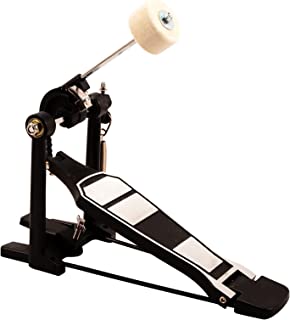
The Foot Pedal for Your Bass Drum. Photo Source: Amazon
The bass drum pedal is connected to the bass drum hoop and is essential to controlling your kick. Bass drums are one of the main time-keeping drums, and your ability to keep up with fast-paced beats will depend on how fast you can hit the bass drum pedal.
Focusing exclusively on how fast you can lift and drop your feet on the drum pedal will limit your top speed. Instead, work on your ankle gear technique, which includes ankle rotation, as shown in this video.
Snare Drum
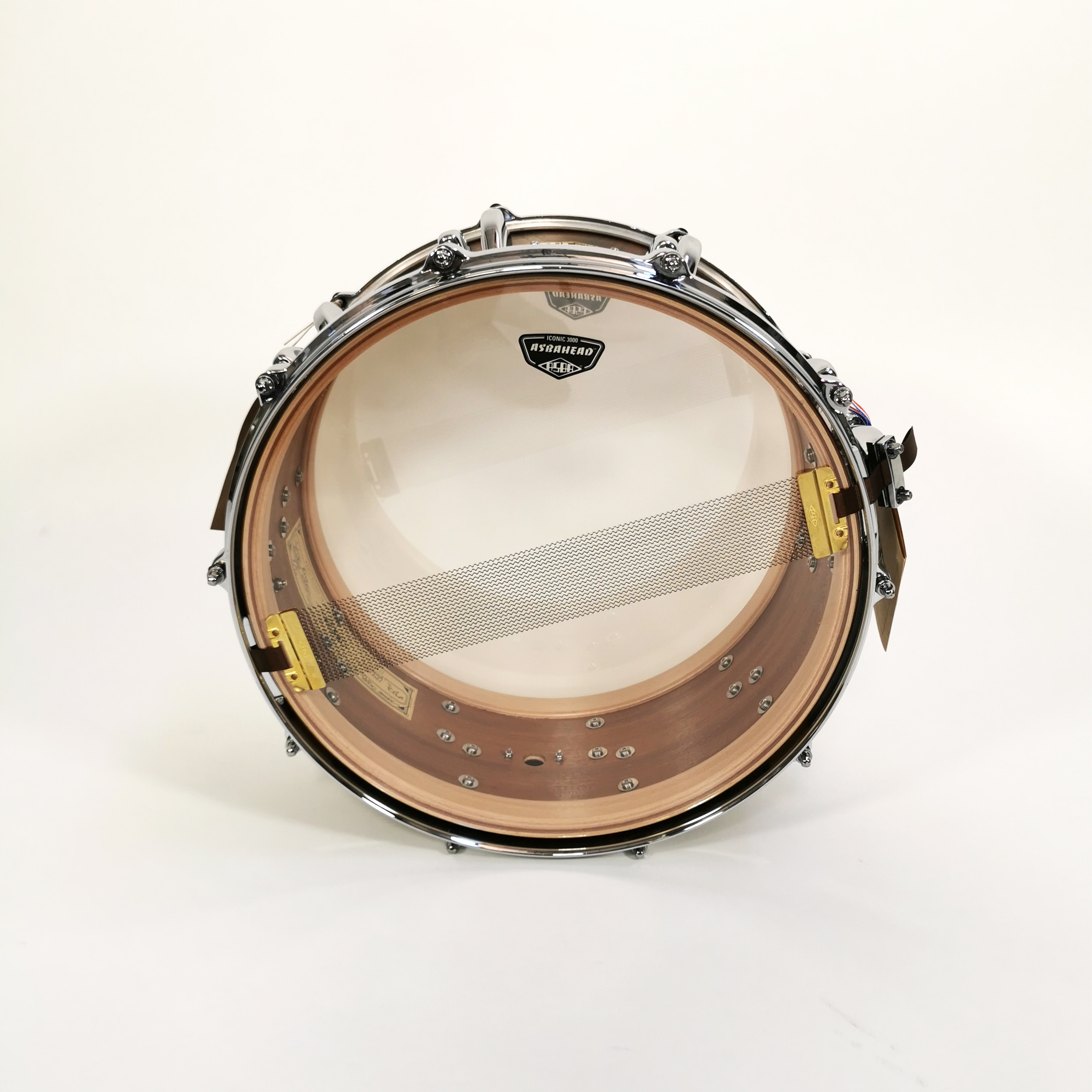
Photo Source: ASBA Drums on Unsplash
The snare drum should be placed between your legs and is one of the essential parts of the drum kit because of its utility in providing the backbeat, as well as strong accents and fills.
Snare drums have two drum heads with unique builds. The drum head you play against is called the batter head, and the one on the other end of the frame is called the resonant head. The major difference between both drum heads is the snare wires underneath the resonant head. The snare wires are responsible for the staccato sound that snare drums make. Staccato is Italian for detached and refers to the classic cracking sound that snare drums make when hit. The snare drum is sensitive and reactive to the slightest strokes. This is why you can make impressive beats using only the snare and kick drums for the bass.
To tap into the versatility of the snare drum, you need to focus on several factors, such as where you hit the snare drum. A direct center hit on the snare drum will make a different sound compared to a low stroke to the edge.
Another way in which the sound of a snare drum can be adjusted is through the tension in the adjustable snare wires. The snare wires are connected on both ends by a snare strainer, giving you even more control over your sound once you learn to tune them.
Tom Toms
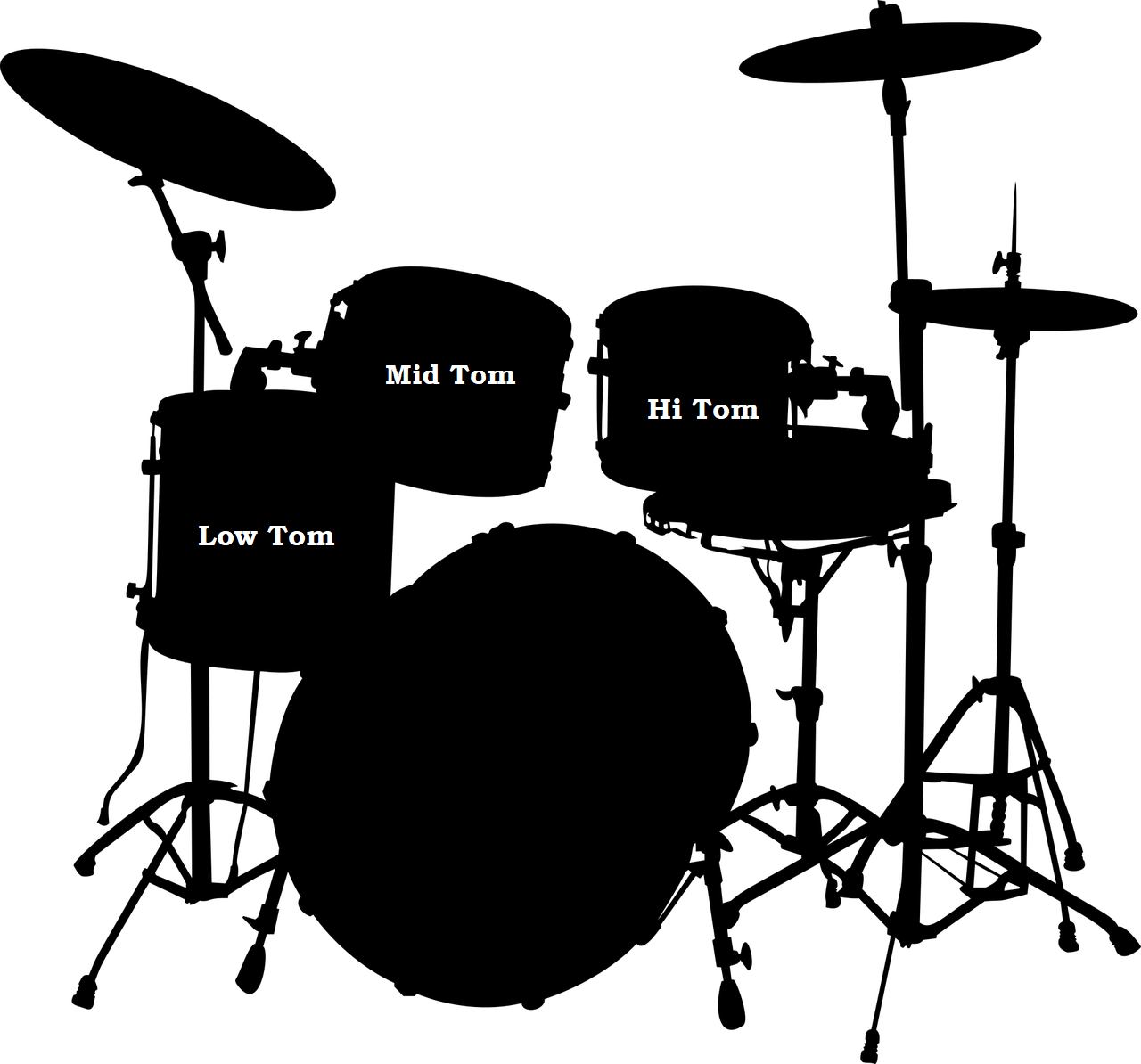
The Tom Toms. Photo Source: Audioauralcymbals via Pixabay
Toms or tom toms are drums that bring variety to your drum set as they provide different tenor pitches to balance out your sound. A five-piece acoustic drum kit has three toms:
- High tom
- Mid tom
- Floor tom or low tom
Toms are not used as often as the bass and snare but are key parts of drum fills. Most toms have drum heads on both sides of their shells but do not have wires like the snare. This doesn’t mean that tom toms aren’t versatile. Some of the factors that can affect the sound of your toms include:
- The type of materials used to create the drum frame and head
- How the drums are tuned
- The depth and diameter of your toms
The major differences between these three toms are the pitches they produce and how they are arranged.
High Tom
The high tom is one of the two toms placed on a rack above the bass drum. The high tom produces a sharp and thin sound and has a higher pitch than other toms. High toms are the smallest of the three and are placed on the side closer to the hi-hat cymbals.
Mid Tom
The mid tom is the second of the two rack toms hung above the bass drum. The mid tom produces the same sharp and thin sound as the high tom but has a lower pitch and is bigger.
Floor Tom
Floor toms or low toms stand on three legs, unlike the high and mid toms, and produce the lowest pitch of the three basic toms. Some modern five-piece drum kits allow you to hang floor toms, but they retain their name because they produce the lowest pitch of all three toms. Floor toms are placed under the ride cymbal and on the opposite side of the hi hats.
Cymbals
Cymbals bring the most variety out of all drum set parts. They are percussion instruments that come in various sizes and are usually made of bronze, an alloy of tin and copper. High-end cymbals are made of cast bronze, while more affordable ones are made of sheet bronze. Since sheet bronze is lighter, sheet bronze cymbals have a higher and brighter pitch. There are many different types of cymbals, and each one can vary in sound depending on different factors.
Hi-Hat
Hi-hat cymbals are two cymbals that are placed on top of each other and controlled by a pedal that adjusts the distance between them. In most cases, the top cymbal is lighter than the bottom, and this size difference gives you many playing options. Hi-hats are part of every standard drum kit and can be played in many different patterns to provide accents on drum beats. Some of the most popular techniques to control the hi-hats are:
- Closing the hi-hats by stepping on the foot pedal to erase the distance between the cymbals. Hitting the top of the closed cymbal in steady rhythms will cause a vibration between both cymbals, creating an open and sizzling sound.
- Leaving the hi-hats open by keeping your leg off the foot pedal. This reduces most of the vibrations that would have occurred and creates a softer and thinner ring.
- Holding the hi-hat cymbals at a half-open point by stepping on the pedal halfway through. Hitting the top cymbal this way causes minimal vibration and creates a unique sound.
- Playing the high hat by opening and closing it without using the sticks.
- Combining these techniques into more complex patterns.
Free Drum Lesson: EASY Hi-Hat Tricks For AMAZING TRAP Beats!
Hi-hat cymbals are also one of the main time-keeping cymbals and can be used to create a high and explosive crash. Hi hat cymbals are placed on a cymbal stand beside the snare drum so that the drummer's left leg (if right handed) can access the foot pedal with ease.
Ride Cymbals
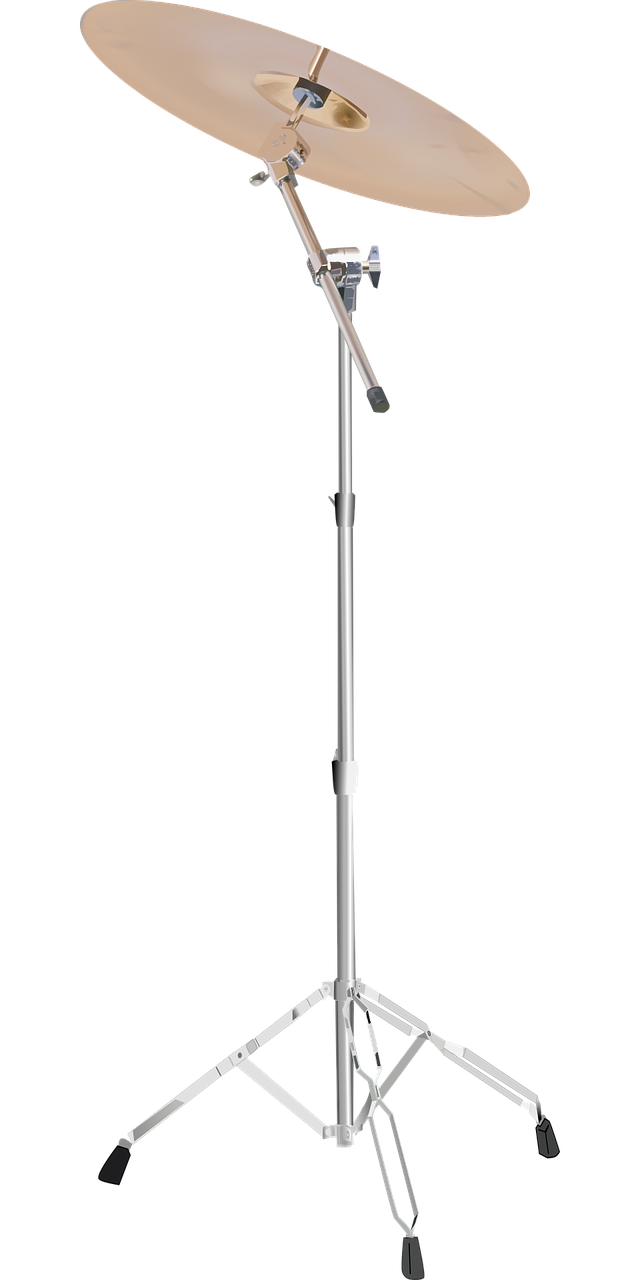
A a ride cymbal all on its own. Photo Source: Pixabay
Ride cymbals are the largest cymbals on the set and are unique parts of the drum kit that provide a rhythmic pattern. Ride cymbals are played like hi-hat cymbals and shouldn’t be used if you’re looking for a loud and explosive crash. A broken ride cymbal might be the result of a drummer using it as a crash cymbal.
To master this cymbal, you need to practice how to strike, touch, or stroke it to get the sound you want from it. Your control will depend on your grip, the flexibility in your wrist, and how you hit the ride cymbal.
Crash Cymbals
Crash cymbals are the loudest and brightest of all cymbals. They make the classic crash sound and can sustain notes for longer than any other cymbal when hit with the stem of the drumstick. Five-piece drum sets commonly have one crash cymbal fitted beside the hi-hat cymbals, but there are no rules, and rock musicians often have multiple crash cymbals. When played together, they enhance the crash sound.
Learning to play the crash cymbal involves more than using it to punctuate rhythms. The crash cymbal can also be played as you would a ride or hi-tom. You can play patterns that enhance drum fills or build tension as you approach a crescendo.
Effects Cymbals
Effects cymbals are cymbals that provide special sounds and effects different from the other cymbal types. There are many different types of effects cymbals, some of which are much more common than others.
Splash cymbals are similar to crash cymbals but are smaller and thinner. They give a sharp splash sound and are versatile in placement. They are mostly used to provide short accents and are part of many six-piece drum kits.
China cymbals are crash cymbals that create a brighter and more explosive crash compared tom regular crash cymbals. Often they are mounted upside down on cymbal stands so they are easier to reach while playing and the sound travels more freely.
Other examples of effects cymbals and percussion instruments that can be mounted on your drum kit are cowbells, ching rings, and wind chimes.
What Cymbals Does a Beginner Need?
Cymbals may seem overwhelming, so if you are a beginner it's a good idea to stick to the basic setup which includes a hi-hat, ride, and crash cymbal. Once you feel comfortable using your basic setup, you can explore new options and collect your preferred combination of cymbals for your ideal drum kit.
Related Reading: "Learning How to Play Drums: A Beginner's Guide"Drumsticks
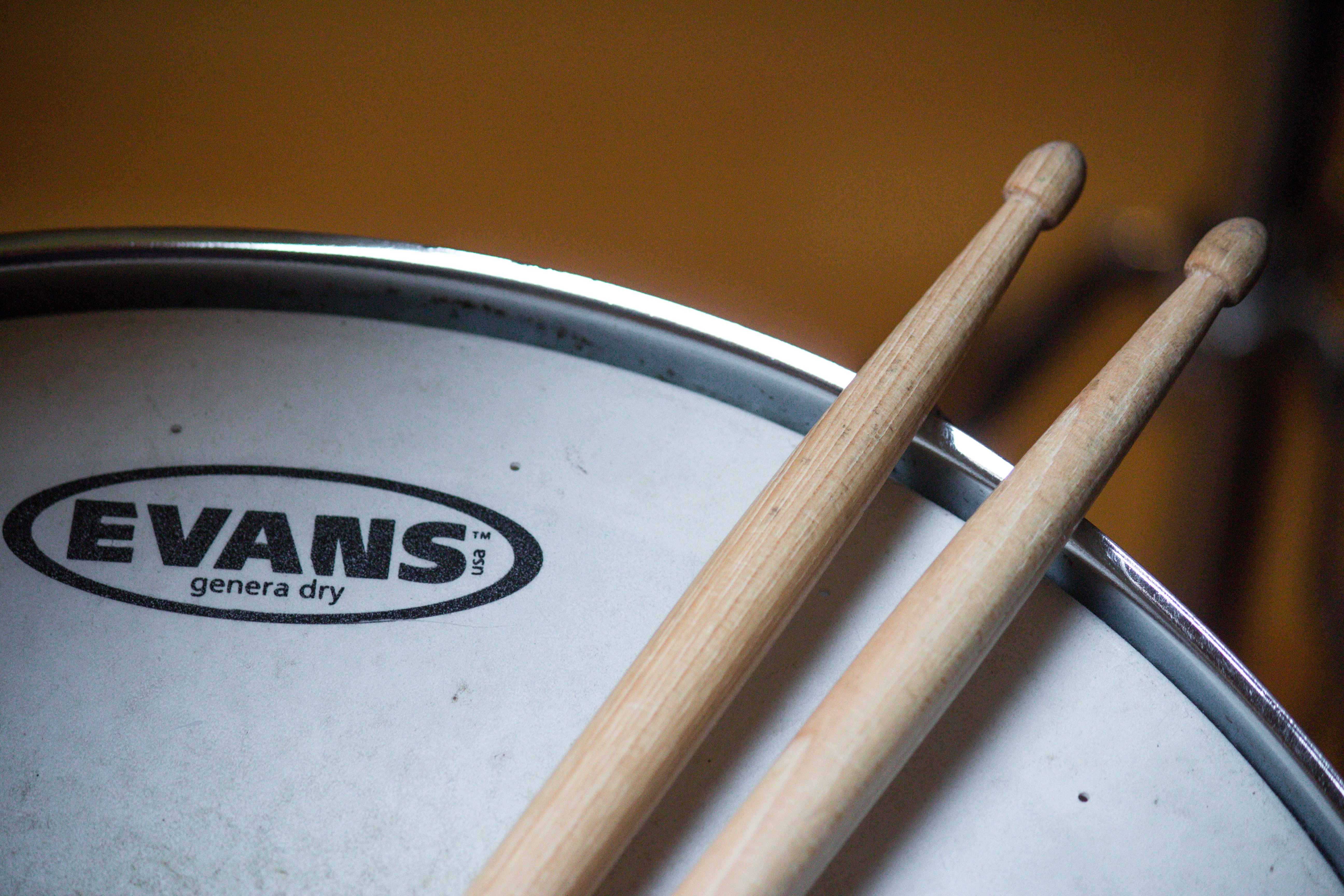
And who could forget the drum sticks?!? Photo Source: Denise Jans on Unsplash
Drumsticks are vital components of your drum set and have a high influence on your sound. They come in varying materials and thicknesses and have different types of tips. Most drumsticks are made of wood; the most common wood types are oak and maple. There are also plastic and metal drumsticks, but most drummers prefer wood.
Metal drumsticks do not have as much recoil as wooden ones, and plastic drumsticks have a more uniform high pitch around their tips than wooden sticks. The weight of your sticks can also affect how you sound. Lighter sticks and brushes make softer sounds and are better for genres like jazz, while heavier sticks are more suited for louder genres like rock music.
Most drummers use wooden sticks because they give warmer sounds, but each material is unique, and the best option is a matter of personal choice. One tip is to consider how fast you want to play when deciding how heavy your sticks should be. Thinner or light sticks are the best option for a beginner or anyone who wants to play light and quick beats.
How to Hold a Drum Stick
There’s more than one right technique for holding drumsticks. Wrong techniques don't practice proper finger and palm placement which puts strain on the wrist. Here are the two most common drumstick gripping techniques:
|
Grip Name |
Summary |
Technique |
Used In |
|
Traditional Grip |
Each stick is held in a different way.
|
In one hand, the drumstick sits between the crook of your index and thumb finger, with your hand positioned for a shake. In the other hand, the drumstick is gripped with a matched grip with the wrist turned to a 45-degree angle. |
Military, brigade, and jazz as it is best for rudiments. |
|
Matched Grip |
Both sticks are held the same way. |
The stick is pinched between the index finger and thumb in a fulcrum-like grip. |
Most music genres as it is better for wrist strokes. |
Drum Throne
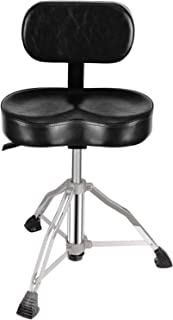
Every drummer needs their throne. Photo Source: Amazon
The drummer's seat or throne dictates your comfort while you play drums. Your drum throne can affect the speed and precision of your leg movements. To pick out the right drummer seat, the three major features to look out for are:
- Adjustability
- Balance and stability
- Cushioned seat so your movements can be natural and easy
Your comfort also depends on how high or low your seat is. It’s best to set your drum throne in a way that lifts your hips a little above your knees. This will put less strain on your muscles and allow you to move your legs like a professional.
Metronome
The metronome isn’t a regular part of the drum kit, but is one of the most important drum set parts to have as a beginner drummer. Drummers are the time counters, but this skill must be learned, and the metronome is the best way to do this.
A metronome is a timer or counter that marks beat or tempo at any rate you choose. This will keep you from increasing or decreasing your tempo by accident. The good news is you don’t even have to purchase one and can download a metronome app for free. If it isn't loud enough, use a speaker or headphones.
Getting Your First Drum Set
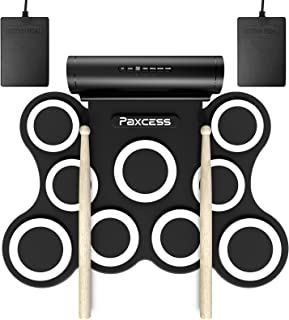
The quieter drum alternative. Photo Source: Amazon
Considering the number of parts in the basic drum set, it's no surprise they don't come cheap. The average beginner drum kit can cost anywhere from several hundred dollars to over a thousand, which may not include certain other percussion instruments you're interested in. The price tag attached to drum kits is one reason that many drummers wait months or years to buy their first kit.
Instead of waiting, you could consider drum pads or electronic drums as affordable alternatives that could help you practice while you save up for a drum kit. Electronic drums might teach you less than an acoustic drum kit, but it's much better to have a pad to practice on than to use any other surface.
Want to Learn to Play Drums?
Drum Beats Online is the most active and positive community for drummers at different stages of expertise. If you’re a beginner drummer, structured practice, as well as direction, feedback, and support can improve your skills by leaps and bounds. Drum Beats Online provides you with a path from your current stage of drumming to becoming a master drummer with a free four-part course called the Master Drummer Roadmap. Sign up below!
Members of Drum Beats Online get access to an extensive collection of pre-recorded drum lessons taught by professional drummer Gabe Helguera from rock band ‘I Prevail’, that are short enough to complete in a few minutes.
There are various options to start learning with the Drum Beats Online community. Of course, there is free access to the Youtube channel, as well as a monthly ($29.95), annual ($250), and lifetime ($750) subscription to all lessons and the DBO community.
Get started with Drum Beats Online to enjoy access to a world-renowned course library and so much more today!


